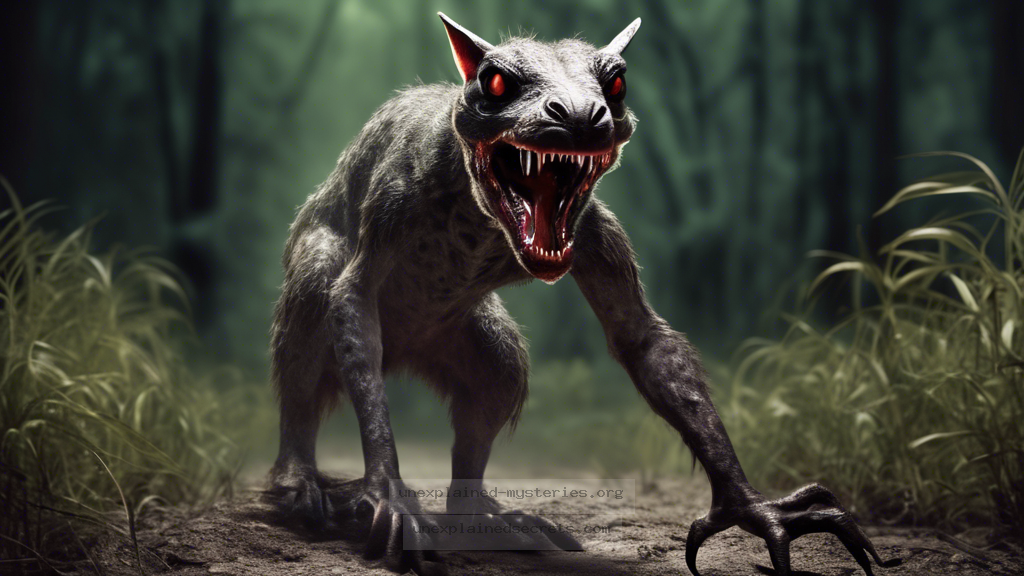What Happened to the Chupacabra: Myths, Sightings, and Scientific Investigations?
What Happened to the Chupacabra: Myths, Sightings, and Scientific Investigations?
The Chupacabra is one of the most notorious cryptids in modern folklore, captivating the imagination of monster enthusiasts and skeptics alike. But what exactly is the Chupacabra, and why does its legend endure? This post delves into the mysterious circumstances surrounding this creature, exploring its origins, notable sightings, and the scientific investigations that seek to explain this enigmatic entity. Understanding the Chupacabra goes beyond mere storytelling; it taps into cultural fears, ecological concerns, and the intersection of myth and reality. Let’s unravel this mystery together!
Historical Context of the Chupacabra Legend
The Chupacabra, which translates to “goat-sucker” in Spanish, first emerged in Puerto Rico in the mid-1990s. Reports of livestock mutilations, particularly goats, attributed to this creature surged after a series of bizarre killings were reported in the town of Canóvanas. Witnesses described a small, alien-like creature with spines running down its back, leading to the widespread belief that it was responsible for draining the blood of its victims. The legend quickly spread across Latin America and eventually made its way to the United States, where it became a cultural phenomenon.
The Chupacabra’s popularity can be attributed to its blend of fear and fascination. It embodies the anxieties surrounding genetic mutations, environmental changes, and the unknown. As such, it reflects deeper societal issues, such as fear of the unfamiliar and the consequences of urban expansion into wildlife habitats.
Core Concepts: What Do We Know About the Chupacabra?
Despite numerous sightings and claims, the Chupacabra remains elusive. The core characteristics associated with the creature have varied widely, leading to confusion and speculation. The original descriptions from Puerto Rico depicted a creature roughly the size of a small dog, with a row of spines along its back, large red eyes, and a pronounced jaw. However, subsequent reports from different regions have suggested various forms, including those resembling canines or even reptilian creatures.
- Size: Typically described as being the size of a small dog.
- Appearance: Spines or quills along the back, large eyes, and a pronounced jaw.
- Behavior: Noted for attacking livestock and draining blood.
Notable Sightings and Encounters
Countless sightings of the Chupacabra have been documented over the years, with some of the most notable cases occurring in Puerto Rico, Texas, and Mexico. In 1995, a series of livestock killings in Puerto Rico prompted local authorities to investigate. Farmers reported finding their goats drained of blood, with puncture wounds on their necks. Witnesses claimed to see a creature lurking nearby, fueling the legend’s growth.
One particularly famous sighting occurred in 2000 in the town of Cuero, Texas, where a creature resembling the original Chupacabra was captured and photographed. This incident reignited interest in the cryptid and led to further investigations. In 2007, a woman in the town of Laredo claimed to have seen a Chupacabra attacking her chickens, providing a vivid description that matched earlier accounts from Puerto Rico.
Scientific Investigations: What Do Experts Say?
Despite the numerous claims surrounding the Chupacabra, scientific investigations have sought to debunk or explain the sightings. In many cases, animals that were believed to be Chupacabras have been identified as common species suffering from mange or other health issues. For example, a series of hairless canines found in Texas were initially thought to be Chupacabras, but DNA testing revealed them to be coyotes afflicted with sarcoptic mange, leading to their hair loss and emaciation.
Research conducted by biologists and wildlife experts has primarily focused on understanding the ecological factors contributing to the sightings. As urban development encroaches on natural habitats, wild animals may venture closer to human settlements, leading to increased encounters. This shift can create a breeding ground for myths and legends, as people seek explanations for their experiences.
Alternative Perspectives: Cultural Significance of the Chupacabra
Beyond the scientific lens, the Chupacabra serves as a cultural symbol, representing the fears and anxieties of specific communities. In Puerto Rico, the creature became a metaphor for the socio-political climate, often linked to issues such as migration, economic instability, and environmental degradation. The Chupacabra myth has also evolved to reflect the ongoing struggles of rural communities facing the challenges of modernization.
Moreover, the creature has become a staple in popular culture, influencing movies, TV shows, and even video games. The Chupacabra’s presence in media reinforces its status as a contemporary myth, further embedding it in the collective consciousness.
Common Misconceptions About the Chupacabra
Several misconceptions surrounding the Chupacabra persist, often fueled by sensationalized media reports and anecdotal evidence. One common myth is that the Chupacabra is a supernatural being or an extraterrestrial creature. While some believers assert it has origins beyond our planet, most credible accounts suggest it is likely a misidentified animal.
Another misconception is that the Chupacabra attacks are widespread and frequent. While reports do emerge, they often lack substantiated evidence and are occasionally rooted in fear or hysteria. Many incidents are later attributed to mundane causes, such as domestic animals or wild predators.
Best Practices for Investigating Cryptid Sightings
For those interested in investigating cryptid sightings, including the Chupacabra, several best practices can enhance the credibility of the investigation. Here are some guidelines to follow:
- Document Evidence: Always document sightings with photographs, videos, and detailed notes about the location, time, and conditions. 📝
- Consider the Source: Evaluate the credibility of eyewitness accounts and seek corroboration from multiple witnesses.
- Engage with Experts: Collaborate with wildlife biologists, ecologists, and local authorities to gain insights into the animal behavior and environmental factors at play.
- Stay Objective: Approach investigations with a skeptical mindset, prioritizing scientific evidence over anecdotal claims.
Future Developments: What Lies Ahead for Chupacabra Research?
The future of Chupacabra research is likely to involve a blend of scientific inquiry and cultural analysis. As technology advances, techniques such as DNA testing and wildlife tracking may provide deeper insights into the creature’s origins and the phenomena surrounding sightings. Additionally, ongoing ecological studies can help understand the behavior of wildlife in urban areas, which may clarify why people are encountering these mysterious animals.
Furthermore, as social media continues to play a role in shaping public perceptions of cryptids, researchers may find new avenues for data collection and engagement with communities. The intersection of science, folklore, and technology will be crucial in demystifying the Chupacabra and other cryptids in the years to come.
Conclusion: The Chupacabra Mystery Continues
The legend of the Chupacabra continues to captivate and perplex, straddling the line between myth and reality. Historical context reveals its roots in cultural anxieties, while scientific investigations challenge the veracity of sightings. Despite the numerous explanations, the Chupacabra remains a symbol of the unknown, inviting curiosity and skepticism in equal measure. As we delve deeper into the realms of cryptozoology, the Chupacabra serves as a reminder of our fascination with the mysterious and the unexplained. Ultimately, whether it exists or not, the Chupacabra will likely endure as a compelling figure in the landscape of cryptids, reminding us of the stories that shape our world. 🌍
Other Articles
Recent Posts
- What Happened to Flight MH370? The Conspiracy Theories That Still Haunt Us
- What Secrets Lurk Within the Walls of the Infamous Trans-Allegheny Lunatic Asylum?
- What Evidence Supports the Existence of Bigfoot in the Pacific Northwest?
- What Happened to the Indus Valley Civilization? Unraveling the Mysteries of Ancient Urban Life
- Can Telepathy Be Scientifically Proven Through Laboratory Evidence?







